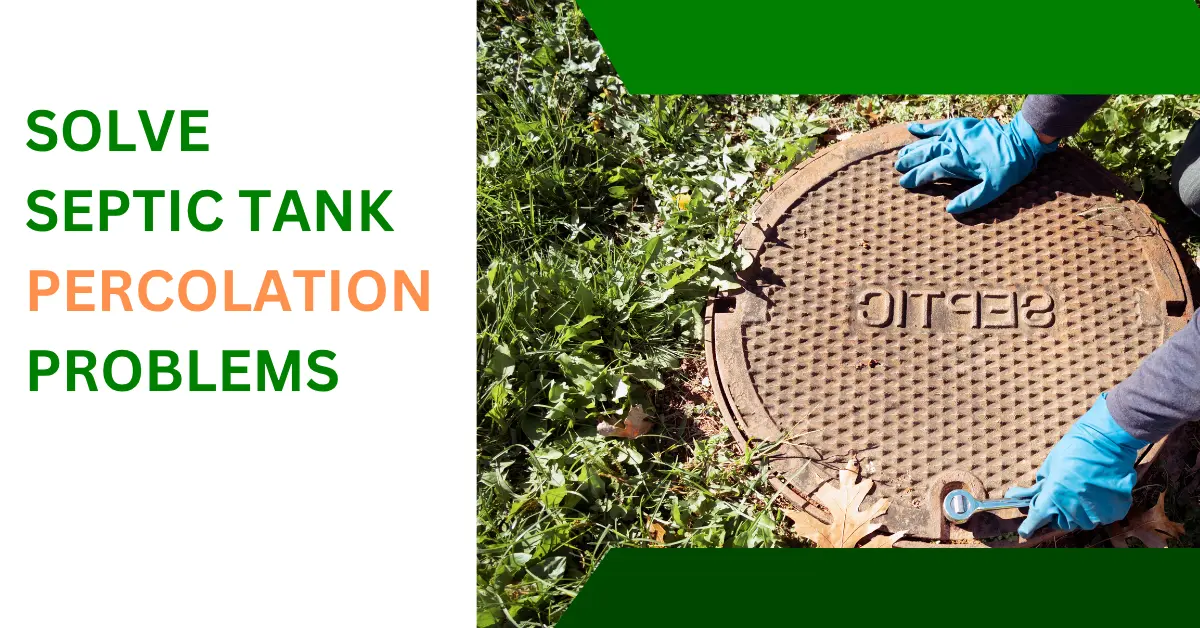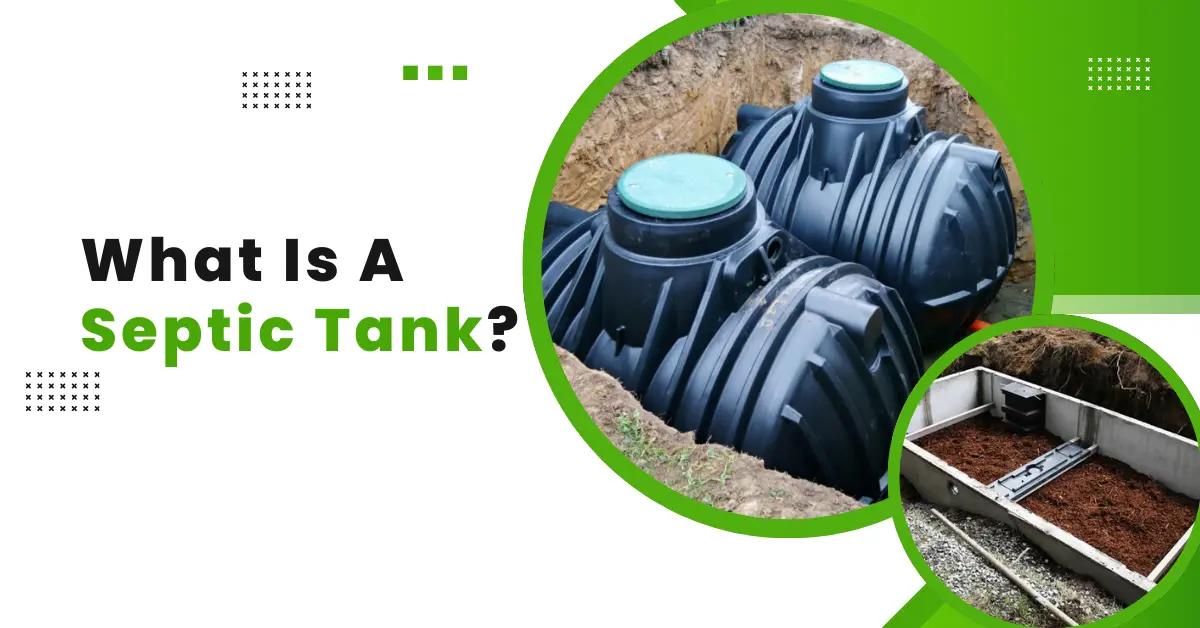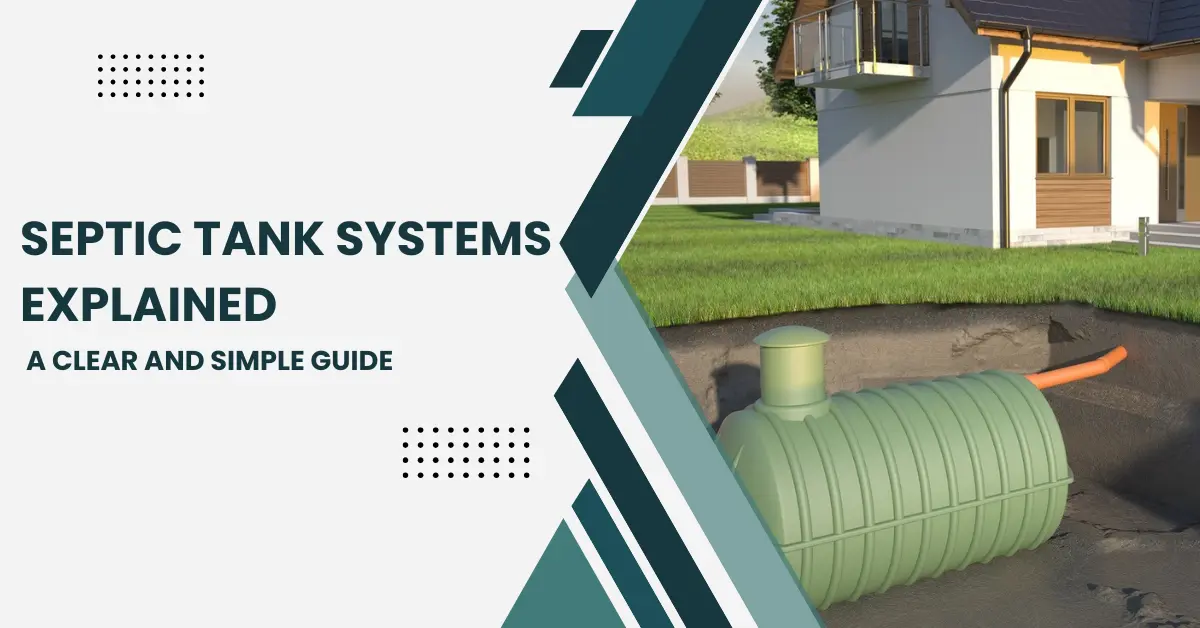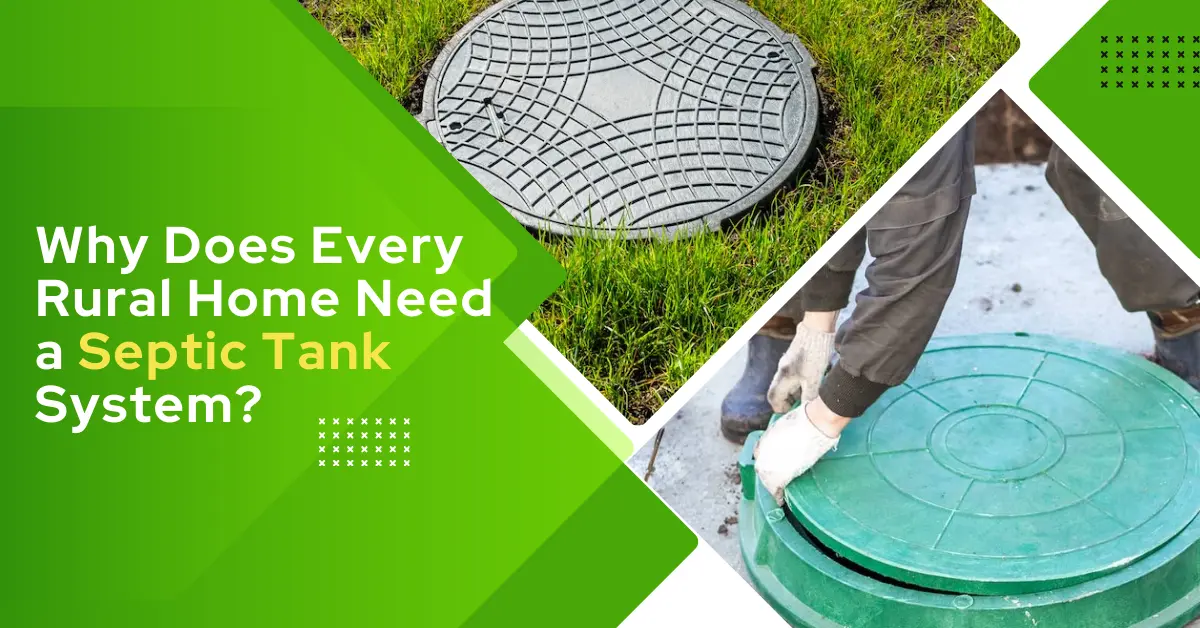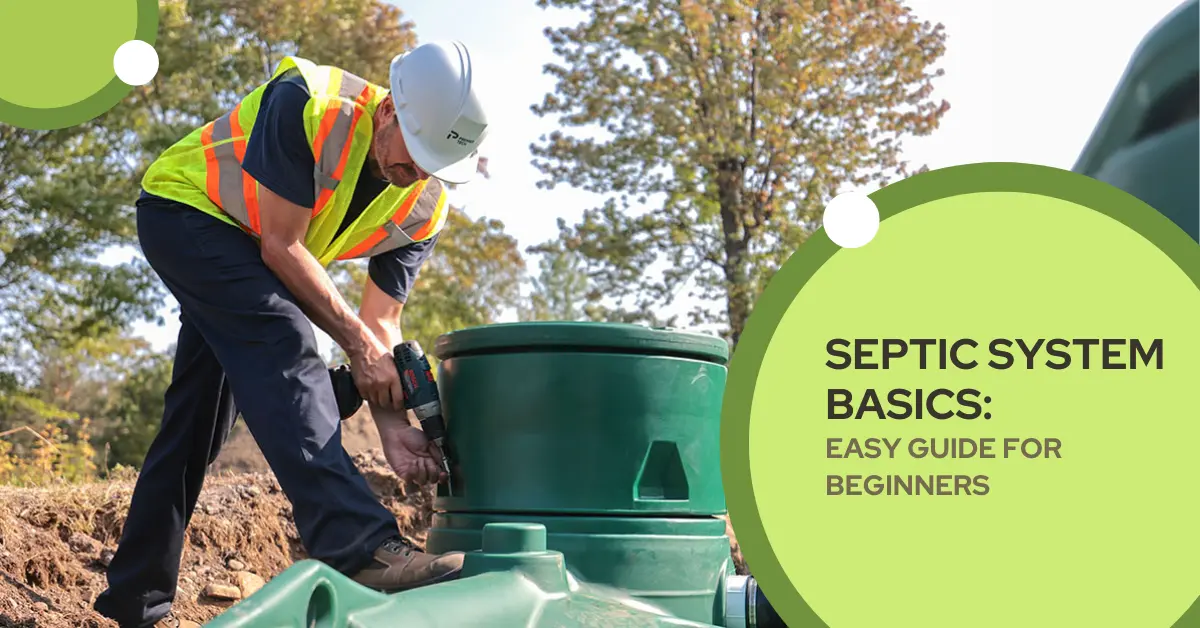A septic tank percolation problem occurs when wastewater can no longer drain properly into the soil. Eventually, it causes backups, foul odors, and potential system failure.
Percolation refers to how treated water filters through soil in the drain field. Many homeowners overlook how it works and miss early warning signs.
The good news is, there are proven solutions: desludging the tank, clearing blockages, repairing or replacing the drain field, or upgrading to modern alternatives like aerobic or mound systems.
This comprehensive guide delves into the workings of septic systems, the importance of percolation, common causes of percolation failures, warning signs to watch for, effective solutions, and preventive measures.
Therefore, let’s get started!
What Is Percolation in a Septic System?
Percolation is the process by which liquids move through soil.
In the context of septic systems, it describes how wastewater leaves the septic tank and gradually seeps into the ground through the drain field.
This area plays a crucial role in naturally purifying the water, as it allows the effluent to spread out evenly.
As the wastewater percolates through the soil, beneficial microbes break down and eliminate harmful contaminants, ensuring cleaner water returns to the environment.
Role in Wastewater Treatment
Once the septic tank has completed its primary role, which involves allowing solids to settle and break down without oxygen, the remaining liquid flows into the drain field.
At this stage, the soil takes over as a natural filtration system. As the effluent seeps through the layers of earth, harmful pathogens such as bacteria and viruses, along with excess nutrients, are removed.
This important step helps keep groundwater clean and protects the environment.
How a Healthy Septic Percolation System Works?
Let’s understand how it functions efficiently and helps to walk through each phase of the journey that wastewater takes.
Step 1: Wastewater Leaves the Home
From sinks, toilets, showers, and washing machines, all household wastewater flows through one main drainage pipe into the septic tank.
Step 2: Primary Treatment in the Septic Tank
Inside the septic tank, the solid waste settles to the bottom and forms a sludge layer.
Meanwhile, oils, grease float to the top and create a scum layer.
Between these layers lies a clearer liquid called effluent. Anaerobic bacteria inside the tank begin breaking down the organic material in the sludge.
It reduces the volume and prepares the wastewater for further treatment.
Step 3: Effluent Flows to the Drain Field
Once separation occurs, the liquid effluent flows out of the tank into a network of perforated pipes in the drain field. This is also known as the leach field or percolation area.
These pipes are generally laid in gravel-filled trenches, which help to evenly disperse the effluent into the surrounding soil.
Step 4: Percolation Begins in the Soil
The real magic happens here. As the effluent drips out of the perforated pipes, it begins to percolate through the layers of soil beneath the drain field.
As the water moves through the soil, microbes in the top layers break down harmful pathogens, viruses, and nutrients.
With each layer it passes, the water becomes cleaner and safer.
Step 5: Treated Water Rejoins the Environment
When the soil is suitable and the drain field is properly designed, treated water filters back into the groundwater safely.
A healthy system runs quietly and smoothly, with no surface water, bad odors, or visible issues.
Ideal Soil Conditions for Percolation
| Soil Type | Suitability | Notes |
| Sandy | Risky | Drains too fast & has poor filtering |
| Clay | Poor | Drains too slow & system backups |
| Silty | Problematic | Compact easily & drainage issues |
| Loamy | Best | Balanced drainage & filtering |
Always perform a percolation test before installation.
What Causes Septic Percolation Problems?
A well-functioning septic system relies on the efficient percolation of effluent through the soil in the drain field. However, several factors can block this process.
1. Poor Soil Conditions
According to a University of Kentucky Agricultural study, septic system failures are often caused by clay-heavy or compacted soils that prevent wastewater from being absorbed.
The study notes that wet soils with poor drainage can saturate the soil and leave no room for effluent to percolate, causing surface pooling or backups.
In addition, research from the Environmental Protection Agency (EPA) emphasizes the importance of soil percolation rates in septic system design.
They also note that slower percolation rates necessitate larger drain fields to handle wastewater effectively.
2. Neglected Maintenance
A publication by Kansas State University reveals that one of the most preventable causes of septic system failure is insufficient desludging.
When septic tanks aren’t pumped every 3 – 5 years, solids accumulate and eventually clog the percolation area.
3. Tree Root Intrusion
Tree roots can penetrate septic system components and lead to blockages and structural damage.
The EPA notes that roots seeking moisture can enter and obstruct pipes, which compromises the system’s functionality.
4. Pipe Blockages or Structural Failures
Driving heavy vehicles over the drain field crushes pipes, which leads to leaks or blockages.
Additionally, improper disposal of grease and fats can solidify within pipes. Eventually, it causes obstructions that hinder wastewater flow, sometimes mimicking the signs of a leaking septic pipe, such as odors or surface pooling.
5. Groundwater Level Changes or Site Alterations
High groundwater levels soak the drain field, which reduces its ability to absorb wastewater and causes backups.
Construction or landscaping changes shift drainage, pool water over the field, and disrupt how it works.
6. Biofilm or Bacterial Build-up in the Soil
Over time, a layer of bacteria and waste called biomat builds up in the drain field, clogs the soil, and blocks water from soaking in.
This phenomenon, referred to as bioclogging, is a recognized issue in septic system performance.
Proven Solutions to Septic Percolation Problems
There are both immediate and long-term solutions depending on the cause and severity of your percolation issue.
Below are expert-backed remedies based on environmental authority guidance.
1. Immediate Fixes
✔ Desludging (Regular Septic Tank Pumping)
One of the most effective first steps is desludging. Septic tanks should be pumped every 3 – 5 years to remove sludge and prevent overflow into the drain field.
According to the U.S. EPA, failing to pump regularly is one of the leading causes of system failure.
Regular desludging keeps solids out of the drain field and restores percolation.
✔ Temporary Water Use Reduction
Cutting down on water usage temporarily, especially during heavy rain or after a backup, can allow your drain field to recover.
This may include spacing out laundry loads, taking shorter showers, or fixing dripping taps.
Lower water volume = less pressure on a saturated drain field.
2. Drain Field Repair or Partial Replacement
✔ Pipe Cleaning or Replacement
Cracked, collapsed, or clogged pipes can interrupt the flow of wastewater. In many cases, jet cleaning or replacing damaged sections can restore function without needing a full system overhaul.
✔ Root Intrusion Removal
Tree roots are a silent septic killer. They invade drain lines and create physical blockages.
Studies from the EPA and plumbing industry sources show root intrusion as a top cause of percolation failure.
The solutions can be mechanical root removal, avoiding planting trees near the drain field, or using root barriers.
3. Full Drain Field Replacement
If your percolation area is beyond repair due to long-term saturation, biofilm buildup, or site disturbance, you’ll need a complete drain field replacement.
- When: When water pools consistently and backups persist despite repairs.
- Why: Old age, bio-clogging, site alteration, or poor design.
- Cost: $3,000–$15,000 depending on system type, soil conditions & location
4. Modern Septic Alternatives (When Percolation Isn’t Possible)
When soil conditions are unsuitable or percolation has permanently failed, alternative treatment systems offer reliable, often more sustainable options.
✔ Aerobic Treatment Units (ATUs)
Aerobic Treatment Units (ATUs) pump in oxygen to help bacteria break down waste faster, which results in cleaner, safer effluent.
These are ideal for sites with poor soil or near water bodies.
✔ Mound Systems
A raised sand and gravel bed above the natural soil level, designed for shallow soil or high water tables. These are effective where groundwater is too close to the surface.
✔ Constructed Wetlands
Man-made wetland systems mimic nature to filter wastewater using plants and soil bacteria.
These are very sustainable and visually appealing. Ideal for eco-conscious homeowners with space.
✔ Drip Distribution Systems
Effluent is slowly and evenly distributed through a network of shallow tubes, and allows maximum absorption in a controlled way. Especially useful for clay or compacted soils.
How to Diagnose a Septic Tank Percolation Problem?
This section walks you through DIY checks and professional methods used to detect percolation issues with precision.
Step 1: Perform a Basic Homeowner Inspection
You can begin with a simple, non-invasive inspection around your home to catch early signs of septic trouble.
Look out for soggy patches or standing water over the drain field, especially if it hasn’t rained recently.
Pay attention to slow-draining sinks, tubs, or toilets, as well as unusual gurgling sounds coming from the plumbing. These can be signs of a septic tank problem, especially if they occur throughout the house rather than in a single fixture.
Foul sewage odors near the tank or drain field are another clear warning.
Also, if you notice one area of your lawn has unusually lush, fast-growing grass, it could indicate wastewater leaking into the soil.
Step 2: Know the Difference – Tank Issues vs. Field Failures
If your septic tank has a problem, you might notice it overflowing, sewage backing up into the home, or strong odors coming from around the tank lid.
During inspection, high levels of scum and sludge can also signal trouble.
On the other hand, if the issue is in the drain field, the signs are different. You might see surface pooling on your lawn.
The soil may feel soggy or squishy underfoot. Foul sewage smells can rise from the ground. Toilets or drains may bubble, even without a visible clog.
Recognizing where the problem starts helps you take the right action faster.
Step 3: Conduct a Percolation (Perc) Test
A percolation test checks how quickly water drains through soil, which helps determine whether your septic system can function properly.
When should you do it?
Before installing a new system, when replacing or renovating a failed one, or if you notice signs of a saturated drain field.
A failed perc test means the soil can’t absorb wastewater well. In that case, alternative systems like a mound system may be needed.
How is it done?
A test hole is dug, usually 6 to 12 inches wide and 24 to 30 inches deep. It’s filled with water, and you measure how many minutes it takes for the water level to drop by 1 inch.
While homeowners can try a basic version, only a certified professional can provide official results required for permits or replacements.
Step 4: Schedule a Professional Septic System Inspection
Here’s a quick guide to common septic system inspections and what each one checks.
- Camera Inspection: Uses a small camera to visually inspect pipes for cracks, clogs, or root intrusion.
- Soil Percolation Test: Measures how quickly soil can absorb wastewater.
- Flow Test: Tracks how water flows through your system to detect blockages or inefficiencies.
- Level Checks: Verifies that tank levels, scum, sludge, and baffles are within proper working limits.
All About Percolation Testing (Perc Test)
A percolation test, often called a perc test, is a vital part of both installing and diagnosing a septic system.
It tells you whether your soil can absorb wastewater efficiently, which directly affects whether a drain field(or leach field) will work or fail. It answers the key question,
“Can the soil filter and absorb wastewater effectively and safely?”
When Is a Perc Test Required?
A percolation test is mandatory before installing a new septic system, as most jurisdictions need certified results to issue permits.
If you’re replacing or relocating a failed drain field, a perc test helps ensure the new location can handle wastewater properly.
It’s also useful when diagnosing drainage or saturation issues in an existing system.
Planning major home renovations that increase water usage, like adding bathrooms, often triggers the need for a test as well.
And during property development or land purchase, a perc test determines whether the land is suitable for building with a septic system.
Most U.S. states, UK counties, and EU regions require certified results from a licensed septic or environmental engineer before they’ll approve septic permits..
Can You Do a Perc Test Yourself?
Yes, but with caution.
DIY perc tests can give you a rough idea of soil drainage, but they won’t meet legal or engineering standards for installation approvals.
How to DIY a basic perc test
1. Dig a hole about 6 – 12 inches wide, about 24 – 30 inches deep.
2. Pre-soak the soil: Fill with water and let it drain completely (especially in dry soil).
3. Fill again to a standard height (usually 6 – 12 inches of water).
4. Time how long it takes for the water to drop 1 inch.
How Professionals Perform a Perc Test?(Step-by-Step)
Professional perc testing is far more precise and typically involves soil engineers, surveyors, or licensed septic contractors.
1. Site Survey
Professionals first mark test locations based on your house plan. They also ensure proper distance from wells, water bodies, and property lines.
2. Soil Profile Evaluation
They dig test pits (usually 2 – 6 feet deep) to check the soil layers, compaction, and the depth of the water table.
3. Test Hole Preparation
Holes are dug to the required size and soaked with water for several hours to simulate saturated conditions (pre-saturation).
4. Perc Test Execution
After soaking, each hole is filled with water to a specific depth (typically 6 – 12 inches), and the drop in water level is timed and recorded.
5. Results & Reporting
If the water drains too fast or too slow, the soil may not be suitable for a standard system. Alternatives like ATUs or mound systems may be needed.
In most areas, a percolation rate of 1 to 60 minutes per inch (MPI) is acceptable. Slower rates generally signal poor soil drainage and call for engineered solutions.
What If You Don’t Have a Working Percolation Area?
When traditional drain fields aren’t an option due to poor soil, limited space, or legal restrictions, there are certified alternatives that can restore or even improve your septic system’s performance.
Here’s what you need to know.
1. When Traditional Percolation Areas Don’t Work?
Several site-specific issues can prevent the use of standard percolation fields.
- High Water Table: Limits filtration and increases contamination risk.
- Poor Soil Conditions: Heavy clay or compacted soil hinders absorption.
- Environmental Restrictions: Protected areas (wetlands, water catchments).
- Past System Failures: Soil already saturated or contaminated from old systems.
- Small or Irregular Lot Sizes: Not enough space for a compliant field.
According to the Irish Environmental Protection Agency (EPA), over 25% of domestic wastewater systems inspected between 2019 – 2020 failed due to inadequate percolation or unsuitable site conditions.
2. Legal & Environmental Implications
Without a working percolation area, wastewater has nowhere safe to go. The discharge can lead to both an environmental threat and a legal violation.
Discharging untreated effluent can pollute groundwater, pose health risks, and lead to serious consequences like fines or legal action.
In most places, you also can’t get planning permission for a new home without passing a percolation test.
Key Regulations
- Ireland: EPA Code of Practice for Domestic Waste Water Treatment Systems
- UK: General Binding Rules (Environment Agency)
- US: Local and state regulations (EPA Clean Water Act)
3. Approved Alternatives to Traditional Percolation Fields
If your land isn’t suitable for a standard soakaway system, don’t worry, there are certified alternatives designed for challenging conditions.
Here are four effective options.
1. Aerobic Treatment Unit (ATU)
This system adds oxygen to speed up bacterial breakdown of waste and produce cleaner effluent.
- Best For: Small plots or places needing higher treatment quality
- Pros: Compact, treats waste efficiently
- Cons: Needs electricity and regular maintenance
2. Mound System
A raised sand mound filters and disperses treated water above ground level.
- Best For: Areas with high water tables or poor soil
- Pros: Works well on wet or compacted land
- Cons: Expensive and more visible in the landscape
3. Constructed Wetlands
This natural system uses plants and soil microbes to clean wastewater.
- Best For: Eco-friendly homes, rural areas
- Pros: Energy-saving, supports wildlife
- Cons: Needs space and takes time to establish
4. Drip Distribution System
Effluent is slowly distributed through shallow, flexible tubing across the yard.
- Best For: Sloped or uneven terrain
- Pros: Even water dispersal, energy-efficient
- Cons: Costly to install and needs a dose tank
Warning Signs of Percolation Field Failure
Identifying these early can save you from expensive repairs or environmental fines.
1. Standing Water or Soggy Soil
Spongy or wet ground near the drain field, even during dry weather, is a strong indicator of system saturation or blocked drainage.
2. Gurgling Drains & Fixtures
Bubbling or gurgling sounds when flushing toilets or draining sinks often point to backed-up or air-locked pipes.
3. Sewage Odors (Outdoors or Indoors)
Foul smells around your yard, toilets, or sinks may signal that wastewater is surfacing or not filtering properly.
4. Wastewater Backup
The most critical sign: water or sewage backing up into toilets, bathtubs, or sinks, indicating total system overload.
5. Slow or Sluggish Drainage
Persistent slow draining in multiple fixtures could mean your drain field isn’t accepting water fast enough.
6. Lush, Unusual Green Grass Over the Drain Field
If part of your yard looks suspiciously healthier or greener than the rest, it might be absorbing excess wastewater.
FAQs
1. How do I know if my percolation field is failing?
Common signs include,
- Pooling water or soggy patches in your yard
- Gurgling drains and toilets
- Lush, green grass directly over the drain field
- Foul sewage odors around the system
- Slow drainage or backup of wastewater indoors
2. Can a percolation problem be fixed without digging?
Yes, some early-stage septic issues can be fixed with simpler solutions like desludging the tank, applying root removal treatments, or using bacterial shock treatments to restore balance. However, if the damage is more severe, like a failing drainfield or major system backup, it often requires excavation and more extensive repairs.
3. How long should a drain field last?
A well-maintained drain field can last between 20 to 30 years. Its lifespan depends on several factors like soil quality, water usage habits, and how well the septic tank is maintained. Regular pumping, avoiding tree roots, and not driving heavy equipment over the field all help extend its life.
4. What happens if you ignore a failing drain field?
Neglecting your septic system can lead to raw sewage surfacing in your yard, backups inside your home, and contamination of nearby groundwater or wells. These issues can cause serious health risks, potential legal penalties, and even full system failure; repairs or replacements can cost thousands.
5. What’s the cost of fixing vs. replacing a failed percolation area?
Fixing a septic percolation problem can cost anywhere from $200 to over $15,000, depending on the severity:
- Minor fixes (like clearing clogs, root removal): $200–$1,600
- Partial repairs (pipe, trench, or distribution box): $1,000–$5,000
- Full drain field replacement: $3,000–$15,000+
- Full system replacement (tank + field): $5,000–$20,000
Conclusion
A septic tank percolation problem occurs when the soil cannot absorb effluent efficiently, leading to system backups or surface pooling.
Causes include compacted soil, high water tables, or bio-mat buildup. Fix the problem by improving drainage, installing a new drain field, or using an alternative treatment system.
If you notice signs like foul odors, soggy ground, or slow drains, don’t delay. Please book a professional septic inspection to catch and fix problems before they become costly.
Flush smart, live clean!

